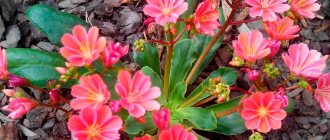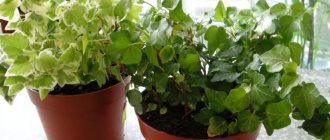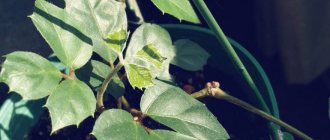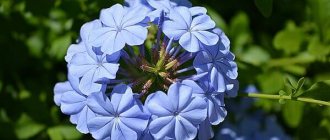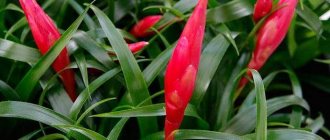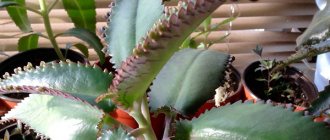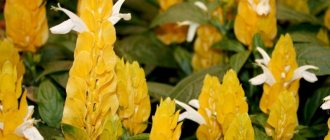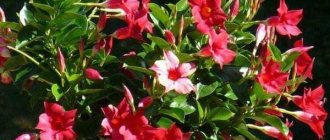Description and features
The peperomia flower is classified as a member of the Pepper family. Natural habitat is tropical South America. The plant is available in different varieties. About 30 subspecies are grown indoors. Each specimen has its own characteristics and unique appearance. There are upright, ampelous or bush-like representatives. The leaves vary in shape, color and size.
Some varieties bloom periodically. However, in most cases, the attractive point is the extraordinary appearance and variety of shapes.
Peperomia magnoliafolia is a perennial with elastic massive leaves that are shaped like magnolia. Color varies from light green to brownish-green and may have spots, borders, stripes and inclusions.
The flower is a neat compact bush, reaching 30 cm in height. Its stems are dense and fleshy. Even in the natural environment, it reaches a length of no more than 50 cm. This is due to the fact that all forces and nutrients are aimed at the formation of massive shoots.
The leaves are smooth and shiny, round or slightly elongated, each about 5 cm in diameter. They are covered with a waxy coating on top.
The flowering of Paperomia magnoliafolia is completely unattractive and occurs at the beginning of summer. Externally, the inflorescences resemble small, inconspicuous spikelets of plantain.
In its homeland, the plant lives for several years. The same lifespan at home, subject to proper care requirements. The flower is heat-loving and when the temperature drops below 10 °C in the natural environment it dies in the first year.
Peperomia looks great in any interior. It also combines well with other indoor plants.
Container growing technology
Peperomia watermelon - home care
To propagate a flower, it is best to use a substrate that allows moisture and air to pass through. In addition to universal soil and soil for ficus, homemade soil is suitable. To do this, you need to mix peat, humus and sand. You can also make a mixture of humus, garden soil, moss, coconut fiber and small expanded clay.
Complex fertilizers must be applied in liquid form. They can be purchased at any garden store. The dosage indicated on the package must be reduced by 2 times for processing. The flower should be grown in a wide, low container. It is necessary to increase its diameter by 1.5 times with each transplant.
What is the benefit
The peperomia bush is popularly known as a “friendly” plant. It is believed that the flower has positive energy and has a beneficial effect on the atmosphere in the house. After settling the plant, people note good omens.
If you have a streak of bad luck in your life, choose a flower with striped leaves. A positive aura will help you overcome difficulties and bring brighter days closer.
It is recommended to give it to people with conflicts, with a contradictory rebellious character. It will help you reconcile with others and bring friendliness and peace into your home environment. Peperomia is so cute and extraordinary that seeing it involuntarily improves your mood.
Helps cleanse and maintain the positive biofield of the home, smoothes out negative influences and emotions, and sets household members in a positive mood and good mood. A bush growing in the office helps to establish friendly relations in the team.
Peperomia improves the air not only at the energy level. The plant secretes phytoncides, which help humidify the air and fight pathogens. It is recommended to place it in rooms where children live. They are most prone to colds. The flower cleanses the room of formaldehyde and other toxic substances.
Peperomia is also believed to prevent the development of diseases. It has a beneficial effect on the digestive system and gall bladder.
Similar flowers
Each flower is unique, but peperonia variegata and these flowers definitely have something in common:
- Maranta.
- Caladium.
- Japanese Fatsia.
- Crassula.
- Dieffenbachia.
- Ficus rubber plant.
In the article, we looked at an interesting indoor plant and found out what variegation is in peperomia. Now you can not only show off your knowledge, but also grow an interesting flower at home.
If you find an error, please select a piece of text and press Ctrl+Enter.
Basics of care
Caring for peperomia magnolia folia is quite simple. If you put in a little effort, the flower will delight you with its freshness and beautiful appearance.
Lighting
Lighting requirements vary depending on color. Specimens with dark leaves tolerate shade well. Variegated and light green plants need more light. The ideal option is indoor lighting. It is better to place the pot some distance from the window. Peperomia should be protected from direct sunlight. With an excessive lack of light, the plant fades and loses its brightness, and can also stretch out.
Temperature
The plant is heat-loving, feels great at 20-24 C. But it should be protected from drafts and temperature changes. Otherwise, he will react with illness. It does not have a pronounced rest period.
Watering
Peperomia is a plant that is more likely to withstand a lack of moisture than its excess. The shoots contain a large amount of water, which is used when the need arises.
The most dangerous situation is wet soil at low indoor temperatures. Under such conditions, the root system may rot. The intensity of watering should be adjusted from moderate in summer to sparse in winter. It is advisable to take water that has been settled and slightly heated.
Indoor humidity
Humidity control will only be required during the heating season. The rest of the time there are no special requirements for this parameter. Spraying is used for moisturizing. To increase humidity, you can place a container of water near the battery.
Top dressing
There is no particular need for frequent fertilization. The soil should be fed no more than 1-2 times a month. Half the standard dosage should be used. Fertilizing is carried out only in the warm season.
Trimming
The plant is pruned to form a lush shape. If the flower has dropped its lower leaves, pinch off the top as well.
In practice, maintaining peperomia is not at all complicated. Don't forget to pay attention to its roots after purchasing. If they are not visible from the holes at the bottom, it is too early to transplant the flower into a new container.
Peperomia - home care, photos and species names
Peperomia is a low-growing, decorative deciduous plant with rosettes of dense, dark green leaves on short, branching stems. Some varieties of flowers are decorated with light patterns in the form of veins, borders or spots.
The succulent came to us from tropical America. The main part of the varieties grow in Brazilian, Colombian, and Mexican forests. Most often they can be found as epiphytes growing on trees.
An unpretentious miniature peperomia with a compact root system is ideal for both a small office space or study, and for spacious winter gardens. Thanks to its modest size, up to 20 cm, it takes root well in the smallest pots and can even be planted with other plants. Some types of succulent reach 50 cm in height, for example peperomia obtufolia.
The flower is perennial; the annual growth of a young plant averages 12 cm. But the older the plant, the smaller and more unsightly its leaves become, so many varieties need periodic pruning and renewal.
| Annual growth averages 12 cm. |
| Peperomia blooms from mid-spring to late summer. The inflorescences have an original, bizarre shape. |
| The plant is easy to grow. |
| Perennial. |
Beneficial features
Needs regular care. In return, it improves the atmosphere in the house, cleanses the air of toxins and formaldehyde vapors, gives a good mood and well-being, creates a favorable aura, and saturates the room with oxygen. The house plant has a beneficial effect on the organs of the digestive system.
Features of growing at home. Briefly
Caring for the plant is not difficult. Peperomia at home is unpretentious and requires standard procedures and conditions:
| Temperature | Sudden changes are undesirable. In summer, the optimal temperature is 22-24C, 16-18C, at lower temperatures it is recommended to reduce watering. |
| Air humidity | Air humidity is not important for the plant, but the higher it is, the better. Daily spraying is required. |
| Lighting | Variegated species prefer bright, diffused light, while others need partial shade. Direct sunlight has a negative effect on the plant. |
| Watering | Moderate, as the topsoil dries out. In summer, at least 3 times a month, in winter - every 2.5-3 weeks. Soft water at room temperature is suitable for humidification. |
| Priming | The soil must be pH neutral and well drained. |
| Feeding and fertilizer | From late spring to early autumn it needs specialized liquid fertilizer. |
| Transfer | Replanting peperomia is required every spring, but you should not increase the size of the pot too much. |
| Reproduction | Reproduction occurs by stem, leaf cuttings, or seeds. |
| Features of cultivation | The peculiarities of cultivation include the plant’s love of heat and humidity. The ideal place would be a kitchen where there are no cold drafts. |
How to buy peperomia correctly
When choosing a plant to buy, you need to pay special attention to its appearance. The leaves should be juicy, elastic, bright, without powdery coating and brown scales. A plant with drooping, limp leaves in moist soil may indicate problems with the root system.
You should not buy such a flower, it can quickly die.
Bloom
Decorative deciduous succulent blooms in early spring and summer. The inflorescences are not particularly beautiful, but have unusual, bizarre shapes that attract the eye. In some species they look like a golf club, in others they look like the tails of mice, in others they look like a comb with many teeth.
The flowers included in the inflorescences are small in size and calm in color.
Temperature
Homemade peperomia is a heat-loving and shade-loving plant; it is not for nothing that in nature it grows in the lower tier of the tropical forest. It must be protected from sudden temperature changes, drafts and hypothermia. Optimal indicators are 16-24C.
In summer, it is not recommended to take the flower outside; dry air and temperatures above 25ºC are destructive.
Hygiene
The juicy, glossy leaves of the flower quickly become covered with dust. To prevent small debris from spoiling the appearance of the plant, it must be periodically cleaned with a damp cloth or rinsed in the shower.
Spraying
The optimal humidity level for a flower is 40-60%. A lack of humidity does not threaten the plant with anything serious, but it is better not to experiment and during dry periods increase the air humidity by periodic spraying. You can place a pot of indoor peperomia in pebbles and pour water into it to evaporate.
Lighting
Comfortable conditions for green-leaved forms of peperomia are diffused light, partial shade. In the summer, they will feel good on the windowsills of eastern, northern and western windows. In winter, the plant needs more light, and southern windows are suitable for growing.
For variegated species, brighter diffused light is needed, but from direct sunlight the pattern on the sheets will become discolored. Therefore, such varieties are grown on the south side, but placed in the light shade of other plants.
To ensure the vital activity of peperomia at home in winter, add additional lighting. It is necessary to extend daylight hours to 16 hours with the help of additional artificial lighting.
Watering
Loves moisture, but is extremely sensitive to waterlogging of the soil. Watering too frequently can cause root rot and flower death. Therefore, it is better to dry it out than to flood it. You can determine the need for watering by looking at the soil if it has dried to a depth of 3 cm. In the warm season, the soil dries out faster than in winter.
Water to moisten the soil should be several degrees warmer than the air in the room.
Pot
Before planting, you should evaluate the size of the peperomia root system. The larger it is, the larger the pot should be. You also need to take into account that it is recommended to add up to 3 cm of drainage layer to the bottom of the pot before planting.
Preference should be given to deep, tall ceramic containers.
Each subsequent replanting is done so that the roots in the pot are distributed evenly and are not located close to the soil surface.
Priming
The choice of substrate for planting peperomia should be taken seriously. Neutral or slightly acidic soil with a pH level of 5 to 6.5 is preferred. Most commercially prepared soils have a high level of acidity and are not suitable. Therefore, 250-350 g of ash or dolomite flour is added to purchased soil for every 10 liters of substrate.
You can prepare suitable soil yourself. To do this, it is recommended to mix sand, humus and peat in proportions 1:1:1 and add 2-3 parts of leaf soil.
Before planting the plant in the soil, it must be treated against pests with a weak manganese solution. At the bottom of the pot, be sure to lay out drainage, at least 2-3 cm.
Feeding and fertilizer
The peperomia flower in indoor conditions requires constant fertilization. In the spring-summer period, fertilizing is carried out at least once every 2 weeks. Specialized complex organic and mineral products for decorative foliage plants are suitable.
The main thing is not to exceed the proportions and dosages specified in the instructions for the drug.
Peperomia transplant
Young plants under 3 years of age need annual replanting. Older flowers can last up to 3 years without changing soil and pot. Some varieties can withstand no replanting for up to 7 years.
The main criterion for the need to increase capacity is the appearance of the plant and the volume of the root system, which can grow into drainage holes or above the soil surface.
Trimming
To give the flower a more branched appearance, pinching the tops above 3-5 leaves or trimming the stem when it reaches a length of 18-20 cm will help. Cuttings and leaves can be rooted in water.
Is it possible to leave without care during the holidays?
When going on a trip, you need to take care of the flower in advance so that you don’t have to urgently resuscitate it later. To ensure that the plant feels good in the absence of proper care, place a layer of wet expanded clay on the soil, and place a tray with wet peat under the pot. It is better to temporarily remove peperomia from the window to the floor.
Growing peperomia from seeds
Before planting, flower seeds do not need long soaking. To speed up germination, they are carefully cleaned of wax deposits on one side and placed in warm water for 40-50 minutes. At this time, the soil is prepared. Place drainage on the bottom of the pot, then a layer of soil with sphagnum. The seeds are placed in the substrate to a depth of 2-3 cm.
The container is left for a week in conditions of sufficient, diffuse lighting. After 7-10 days, the first shoots appear, which should be moistened regularly. Picking can be planned for 30 days after germination. The next plant transplant will be needed no earlier than in a year.
For planting seeds, choose a container 8-9 cm in diameter.
Reproduction
Plant division is quite simple, and several types of propagation are available.
Propagation of peperomia by cuttings
This is the most accessible and popular type of flower division. The cut cuttings are cleared of all leaves except the top ones, left to dry for 1-1.5 hours and planted for rooting in a sand-peat mixture for 1-1.5 months.
The soil temperature should be at least 25C. Many species can be rooted in water. To do this, place the cuttings in warm water and wait for roots to form.
Peperomia propagation by leaf
A leaf separated from the cutting with a petiole of at least 1 cm is treated with root and immersed in a sand-peat mixture. The container is covered with a bag on top and left at a temperature of 19-21 degrees under diffused lighting.
For 1-1.5 months, the soil is moderately moistened, and the pot is turned towards the light so that new rosettes at the base of the leaf form evenly. Then the new root shoots are divided and planted. Their flowering is possible already in the first year.
Some plant varieties, such as silver peperomia, can reproduce from parts of the leaves. The main condition is the presence of a minimum part with which the leaf is attached to the stem.
Diseases and pests
The following problems may arise during cultivation:
- Leaves droop and fall off - insufficient watering. In winter, the reason may be non-compliance with the temperature regime.
- Leaf petioles turn black - excess moisture.
- Blistering occurs on the leaves due to excessive watering.
- Brown tips on peperomia leaves are due to exposure to draft or cold.
- Leaves become limp in winter due to excess moisture, in summer due to excess light.
- Leaves droop with sufficient watering - root rotting due to overwatering.
The most common pests are scale insects, thrips, mealybugs, and spider mites.
Types of Peperomia domestica with photos and names
Among the variety of plant species, the following can be distinguished, the most suitable for home cultivation.
Peperomia obtufolia
Dense, fleshy, dark green leaves on short petioles. They have the shape of an ellipse or an inverse egg, the apex is blunt. The length of the leaf plate is 6-12 cm, width 2.5-5 cm.
Peperomia magnoliafolia
Dense crown, leathery leaves, rich green color, similar to magnolia leaf blades.
Peperomia shriveled
Compact flower with wrinkled, raised leaves. Color – dark green, with brown grooves. Attached close to each other on long petioles of a soft pink hue. Blooms in summer with snow-white spikelets.
Peperomia silver (watermelon)
The ovoid, dense leaves up to 8 cm long are green in color with white, beige veins, reminiscent of watermelon rind. The plant is compact, grows no more than 11-13 cm.
Peperomia climbing
An ampelous plant with oval, pointed leaves up to 5 cm in length. The stem has a pink tint and can curl around a support like a vine.
Peperomia clusifolia
Perennial with large, dense leaf blades 14-16 cm long and 7-9 cm wide. The petioles are short, attached to the stem alternately. The leaves are dark green with a purple or red edge.
Whatever type settles into an apartment or office, it will certainly become a worthy decoration of the room.
How to transplant
If the peperomia loses its appearance and stops growing, check to see if the pot has become too cramped. Perhaps it's time to think about a transplant.
Despite the powerful shoots, the roots of peperomia are short and weak. Therefore, flower growers advise using a shallow container with a solid drainage layer (4-6 cm) for planting.
Transplantation is carried out no more often than once every 2 years. It is best to do this in the spring. The old flower is replanted only when the roots begin to appear from the drainage hole.
As a primer, you can purchase a ready-made substrate for exotic plants. If you want to make the mixture yourself, include the following ingredients: turf and garden soil, humus, peat and coarse sand. Ratio 2:2:2:1:1. Instead of sand, perlite is suitable. It is very important that the soil is loose. Roots easily rot in compacted soil.
The container is chosen 3 cm larger than the previous one. There must be holes for drainage. The pot should not be too spacious. The flower does not feel well in large containers.
What is peperomia magnoliafolia?
Peperomia is an evergreen herbaceous subshrub that can be found in the tropical forests of Brazil, Ecuador and Venezuela. In nature, there are about a thousand varieties of this plant.
Peperomia magnolia leaf reaches a height of 25 cm. Its stem is fleshy and highly branched. The oval glossy green leaves are very dense and are attached to the trunk using short petioles.
The flowers of this plant are quite small. They are collected in ears and in appearance resemble plantain inflorescences. Peperomia is grown indoors for its beautiful leaves, which differ in color and size among different varieties.
Reproduction methods
There are several methods of reproduction.
Cuttings
The most common and effective method of flower propagation. Cut off the top of the shoots with several nodes, after which the cuttings are rooted. To ensure that the root appears as quickly as possible, you can use the biostimulator “Kornevin”. For rooting, take a sand-turf mixture.
It is best to plant the cuttings in a greenhouse container, which will help maintain humidity at the required level. At this stage, the room temperature should be 23-25 C. In the cold, the cuttings easily rot. After the root system begins to develop, transplant it into a small pot.
As for the plant Paperomia magnoliafolia, leaf propagation is also practiced. However, this method does not always give a positive result. Leaves of flowers with a dense texture take root well.
Dividing the bush
When the bush becomes large enough, it can be divided into two parts, carefully separating the roots. Before transplanting, the roots should be disinfected. To do this, they are dipped in crushed charcoal or ash. After planting, do not water for the first week.
Sowing seeds
For beginners, propagating paperomia is quite a task. The seeds are very small, and creating suitable conditions for germination is not easy.
For planting, take a small container. We use a sand-earth mixture as soil. Place the seeds shallowly in the soil. The container is moistened and covered with glass. The room where the seeds are germinated should be warm all the time.
In addition, the container should be placed in a bright place. Avoid direct sunlight. The plant is transplanted into the pot after several leaves appear.
Possible problems in growing
Tupolist peperomia has average immunity. If you care for a flower incorrectly, parasites may appear on it. At the first signs of the disease, a soap solution can help; in case of serious damage, insecticides cannot be avoided.
Attention! Care mistakes: excessive watering can lead to root rot and fungal infection. Excessive sunlight causes leaves to turn pale
If the leaves begin to fall, most likely the air in the room is too cold or the plant does not have enough moisture.
The most common diseases:
- Root rot. It appears as gray-brown wet spots at the base of the stem, which gradually spread to the leaves. Treatment is effective only at an early stage. The plant is removed from the soil, the affected areas are cut off, the roots are soaked in a light pink solution of potassium permanganate, a solution of liquid vitriol or Bordeaux mixture, sprinkled with activated carbon and planted in clean soil.
- Mealybug. The lower part of the leaf plate is covered with a white coating. The scale is washed with a cotton pad soaked in a soap solution with the addition of alcohol or calendula tincture. In advanced cases, insecticides are used.
- Thrips. Parasites can be detected by thin beige lines on the leaves; the leaf blade becomes pale and sticky. Parasites can be caught using sticky fly tape; the larvae are killed with insecticides.
- Nematodes. The leaves become covered with spots, the roots become spherical formations. There is no point in saving a completely damaged plant; it is thrown away, and the pot in which it grew is treated with boiling water. Single affected leaves and roots are cut off, and the plant is treated with insecticides.
- Spider mite. A thin poutine appears between the petioles and stems, and the leaves dry out. Parasites are removed mechanically, the shoots are treated with a soap-alcohol solution, and the larvae are killed with chemical acaricides.
Attention! For preventive purposes, the plant is treated with a quartz lamp once a week, and the Tank is watered with Ecogel once a month. Blunt-leaved peperomia is a tropical beauty that will not grow on every windowsill
Each variety of a given variety may respond differently to standard home care, so conditions must be adjusted experimentally
Blunt-leaved peperomia is a tropical beauty that will not grow on every windowsill. Each variety of a given variety may respond differently to standard home care, so conditions must be adjusted experimentally.
Diseases and pests - how to fight
Peperomia can be affected by some diseases and pests. To eliminate the problem in time, periodically monitor the condition of the plant. Parasites and symptoms of infection may be as follows.
Spider mite
Its presence is indicated by the appearance of a white fibrous coating. First of all, the plant is carefully washed with warm water. After this, they are treated with an insecticide.
Trips
Pests drink the juice from the leaves, after which they become covered with dry spots. They lay larvae on the reverse side. If a problem is detected, the leaves are washed with soapy water. For processing, you need to purchase a special preparation in the flower department.
Diseases
All diseases of this plant are associated with violation of the necessary conditions of maintenance.
- Blackening of leaves occurs due to a sharp drop in temperature.
- Shedding of leaves is due to lack of moisture. This often happens if peperomia is kept next to a radiator in winter.
- Lethargy of leaves occurs from rotting roots or fungal infection due to excessive watering.
- Leaves wrinkling occur when they are exposed to the sun.
You can also read about other types of peperomia: “Clusiefolia”, “Lillian”, “Wrinkled” (Wrinkled), “Bullet-leaved”.
Most popular varieties
Tulipolia is a perennial plant, found in nature both on trees and on the ground. The stems are straight, the leaves are rich dark green, smooth, large, up to 9 cm long and up to 5 centimeters in diameter.
Native to South and Central America. Flowering from late May to early September.
Lilian is a low-growing plant, does not exceed 30 centimeters in height, its characteristic feature is flowers that look like a lily. Flowering in the summer months, after which small berries are formed at the tops of the inflorescences.
Clusifolium - native to the tropics of South America, its distinctive feature is dark green leaves with a purple tint.
Round-leaved is a perennial plant with small green heart-shaped leaves. Grows up to 1 meter.
Whorled - ampelous perennial crop, with oval green leaves. Blooms mainly in June.
Peperomia magnoliafolia, due to its decorativeness and ease of care, is more popular among experienced gardeners and amateur flower growers.
Description
It grows no more than tens of centimeters in length, the stems are dense and strong, the leaves are green, round, about five centimeters in diameter, smooth, attached to the stem with the help of petioles.
The flowers are very small, greenish, reminiscent of plantain spikelets. In addition to plants with monochrome green leaves, there are also specimens with light green with emerald specks or amber with dark green stripes.
Home care
It is considered a fairly unpretentious plant. When growing, the following recommendations must be observed:
Temperature. A fairly heat-loving flower, but it does not like high temperatures. Throughout the year, the most suitable temperature is from 17 to 24 degrees. Avoid: drafts and sudden temperature changes.
Lighting. If you plan to grow on a windowsill, you usually choose the western or eastern direction. Direct sunlight should be avoided, preferably bright, diffused lighting. If the stems are stretched and the leaves become pale, this is a signal of a lack of sunlight. It is necessary to move the plant to the light source.
Watering. For peperomia, a little drought is better than waterlogging. The leaves of this species are able to accumulate a sufficient amount of moisture. Therefore, frequent watering is not required. The water should be soft, settled, a couple of degrees above room temperature. Do not allow the soil to become waterlogged, as this can lead to rotting of the root system.
Air humidity. During the heating season, the humidity level in the room drops, the air is dry, to create comfortable conditions for peperomia, it is recommended to regularly spray the leaves.
The soil. At the flower shop you can buy universal soil or special soil for ficuses. If you want to prepare the soil yourself, remember it must be neutral or slightly acidic.
Gardeners advise preparing using the following components in equal proportions: peat soil, humus, sand. The pot should not be deep. We put a drainage layer on the bottom that will not allow water to stagnate.
Feeding. Feed with a special complex fertilizer
Intended for indoor plants, once every 14 days, during the period of active growth. In the period from December to March, fertilizing can be stopped.
Transfer. Peperomia magnoliafolia does not like transplantation. They are carried out only in cases of extreme necessity, for example, if the plant has grown and there is no longer enough space in the previous pot.
It is important to be careful not to damage the young and fragile roots when transplanting.
Reproduction
There are 3 methods of propagation of peperomia magnoliafolia.
- Cuttings. Shoots with two or three nodes are cut from the upper shoots. Then, for rooting, they are planted to a depth of no more than 4 cm in a pot with previously prepared soil, soil with sand (1:1).
Before the rooting process is completed, greenhouse conditions are created for the cuttings by covering the pot with a plastic bag. The soil requires regular and moderate moisture.
Attention: the room temperature should be 25-26 degrees; at low air temperatures the root will rot.
- Division. The most suitable option when replanting a plant. Peperomia is divided into two parts, carefully untangling the roots. Before planting, the roots are disinfected by treating them with charcoal. Do not water for 7 days.
- Seeds. Plant in a flat container, in non-acidic soil, preferably a mixture of sand and earth. There is no need to deepen the seeds too much, otherwise they may not germinate.
Variety of species
Peperomia belongs to the order of evergreen perennial plants of the Pepper family and has about 1,100 species. Some of them bloom periodically, and about 30 subspecies are grown as houseplants. Almost all of them come from the tropical forests of South America.
Peperomia with variegated leaf color
The most common types of indoor peperomia:
- Fragrant - with pinkish-green leaves.
- Nivali - resembles mini palm thickets.
- Mountain - with cup-shaped, almost round leaves and inconspicuous peduncles.
The variety of types of peperomia
Connoisseurs of everything unusual give preference to the following varieties:
- Wolfgan Krahn - distinguished by a carved frame of greenery.
- Dolabriformis - the leaves of the flower are arranged in such a way that they resemble a large flower.
- Hutchison's Peperomia is a bluish-blue, almost gray plant, somewhat similar to a sea creature.
Peperomia Magnolifolia is one of the representatives of the large Pepper family. The flower differs from its other brethren in its large, massive leaves, similar to magnolia leaves, which is why it received its name. Their color is extraordinary; there are varieties with light green, dark green, even brownish shades, with various inclusions, stripes and borders. The characteristic waxy coating gives the greenery its brightness. The stems are fleshy and quite dense.
The bush can reach a height of 30 cm. The flowers resemble the flowering of an ordinary plantain. The culture is loved by flower growers for its decorative foliage and its ability to release beneficial vapors of phytoncides into the air - excellent helpers in the fight against pathogenic bacteria.
Important! When purchasing a plant in a store, you need to pay attention to the richness of the colors of the foliage. Limp and dull leaves with damage indicate insufficient nutrition and improper growing conditions. After transportation, such a plant is unlikely to survive.
Features of caring for Peperomia Lilian
Caring for a plant is not difficult, but you need to familiarize yourself with the basic growing criteria, find out at what temperature to keep the crop, and how to irrigate it.
Temperature
Due to the tropical origin of the flower, it loves warmth and does not tolerate drafts. In spring and summer, the optimal temperature is 20-22 °C. In winter, the indicator should not fall below 16 °C.
Lighting
The main condition is that the perennial should not be exposed to direct sunlight, so it is best to grow flowers on the windowsills of the eastern and western rooms.
Important! If the side is south, then you will need to create a shadow or place the pot deeper into the room. In winter it is necessary to create artificial lighting
This is achieved through the use of electric lamps. They extend daylight hours
In winter, it is necessary to create artificial lighting. This is achieved through the use of electric lamps. They extend daylight hours.
Also, in the cold season, the perennial needs protection from drafts, but in the summer it can be taken out into the air. With darkening, the crop is brought into the room, since low temperatures and cool winds will harm the plant.
Watering
Watering depends on the time of year. During the growing season, increased irrigation must be provided. It is better to choose soft, settled water without precipitation at room temperature. In winter and autumn, watering is reduced. During this period, the flower tolerates a lack of moisture better than excess irrigation.
Excessive watering leads to the development of fungal diseases. But watering from time to time is simply necessary so that the leaves do not fall off from lack of water.
Important! In summer you can spray the leaves with a spray bottle. This will help wash away dust and give the flower freshness.
Humidity
Home culture does not require creating high humidity in the room. It grows well with or without spraying. The plant develops equally well in dry and humid areas.
Priming
When choosing soil for growing Peperomia Lilian, you need to consider the following criteria:
- the substrate must allow air to pass through well and not clump;
- the soil should not retain excess moisture.
Universal earth
To grow a perennial at home, a gardener can choose one of the following mixtures:
- 2 parts leaf soil and 1 part each sand, humus and peat;
- a mixture of leaf, peat soil and sand, the mass is taken in the same quantity.
Important! Soil acidity should be between 5.5 and 6.5 pH
Feeding
In order for the flower's leaves to remain bright throughout the year, it needs nitrogen-based fertilizers. Ready-made fertilizers for ornamental plants are suitable, containing not only this element in the required quantity, but also other useful substances: manganese, potassium, phosphorus and boron. Peperomia loves organic matter.
In spring and summer, it is recommended to alternate feeding with mineral and organic compounds. They are applied once every two weeks. In winter and autumn, fertilizers are needed, but in limited quantities. The concentration is reduced and the intervals between application and irrigation are increased.
Bio fertilizer with high nitrogen content
